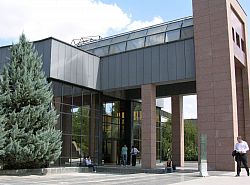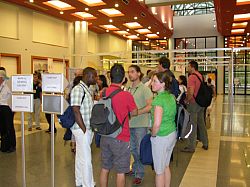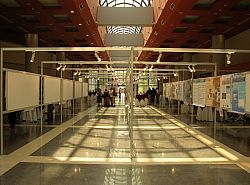COLOSS
A COLOSS (Prevention of honeybee COlony LOSSes) meeting preceded the Eurbee conference at the Middle East Technical University in Ankara, Turkey in September 2010. The COLOSS network currently has 217 members (77 of whom attended the conference), and represents 55 countries, and began with an update from Dr Peter Neumann, Action Chair. A number of plenary talks from invited speakers followed, giving perspectives on colony losses from their home country, before the delegates then took part in a selection of workshops on various aspects of honey bee decline.
An exhibition of posters was available to peruse throughout the COLOSS meeting, including Norman Carreck’s description of the project that he, Dr Karin Alton and Prof Francis Ratnieks are working on at the Laboratory of Apiculture and Social Insects (LASI) at the University of Sussex.
Eurbee
 Middle East Technical University, Ankara
Middle East Technical University, Ankara
The EurBee conference consisted of a series of plenary talks and symposia with various themes including losses, conservation, beekeeping, biology, ecology, and an open session, together with poster sessions and workshops including an update on the progress of the EU Framework 7 Network “BEEs in Europe and the Decline Of honey bee Colonies” (BEEDOC).
The submitted talks and posters covered a wide range of current topics, with several studies of viruses and Nosema in response to concerns about honey bee decline. A range of papers explored the novel use of RNA interference technology for controlling bee diseases whilst others presented molecular techniques on genetic diversity of honey bees. Of probable relevance to the colony loss debate, a number of presentations debated the importance of honey bee nutrition.
Norman Carreck
Norman Carreck delivered two presentations, namely: ‘Intracolony selection for hygienic behaviour in the Dark European honey bee’, and ‘Bee products in human medicine - the need for standardisation’ whilst Dr Karin Alton gave a presentation entitled ‘Public communication of honey bee research’.
Norman Carreck spoke of how a key factor in honey bee colony losses worldwide is undoubtedly the parasitic mite Varroa destructor, which is now present in all major countries apart from Australia. One reason for the continuing losses is that in many areas such as the UK, V. destructor has become resistant to the synthetic pyrethroid acaricides which were previously successfully used to control it. Early studies in the USA showed that certain strains of honey bees exhibit a so called “hygienic behaviour”, which enables them to resist bacterial and fungal brood diseases, and more recently hygienic behaviour has also been shown to confer resistance to V. destructor. LASI are using the novel technique of intracolony selection to enhance hygienic behaviour in the British native honey bee Apis mellifera mellifera, with the aim of reducing the reliance on chemical acaricides in bee colonies. Within a colony that has been selected as “hygienic”, only a minority of the many patrilines present, corresponding to different drone fathers, may actually exhibit the hygienic trait. Selection for hygienic behaviour on a colony basis will therefore be slow. By using molecular techniques to identify which patrilines actually exhibit hygienic behaviour, and then retaining only queens reared from these patrilines, will thus accelerate the breeding process.
 Conference break for a networking coffee
Conference break for a networking coffee
Norman Carreck’s second talk focused on the need for standardisation of bee products in human medicine. In recent years, medical problems such as pathogen resistance to antibiotics have caused a renewed interest in the medicinal use of the products of the bee hive, long used in folklore and traditional medicine, allowing them to take their place among the modern armoury of drugs. Whilst many scientific studies have shown efficacy and safety, many other claims that have been made lack scientific credibility. As with any drug of biological origin, a thorough understanding of the mode of action, and the standardisation of concentration of the active ingredients, together with standardisation of testing methods, are essential. The fact that reports of the efficacy of hive products are often anecdotal, and have hitherto been published in a wide array of journals, books and ephemeral literature, has arguably slowed the acceptance of the use of hive products in “conventional” medicine. The new journal the Journal of ApiProduct and Apimedical Science provides a single forum for peer-reviewed reports of research on the six main hive products of both Apis and non Apis bees: honey, pollen, propolis, wax, royal jelly, and bee venom. Authoritative review papers can also draw together the results of many studies, and provide a platform for the adoption of standardised techniques.
Dr Karin Alton
Dr Alton’s presentation illustrated how public outreach is an important aspect of the work of LASI, and as such LASI operates an open door policy whereby its research and expertise are communicated not only at an academic level, but through visits from politicians, farmers, the media, and both corporate and private individuals. Regular talks are given to colleges, beekeeping groups and at networking meetings. LASI encourages visits from local primary school classes, where learning about bees and the environment has become an integral part of their curriculum. In addition to the public engagement drive, LASI has established a website, www.sussex.ac.uk/lasi which is accessible to all. Information about the research conducted at LASI, under-graduate teaching and pages of resources are available. The website is also an opportunity to keep the public informed about current news and upcoming events in the lab.
 EurBee conference venue
EurBee conference venue
LASI also makes use of social networking sites to disseminate their research. The presentation aimed to highlight the importance of public outreach of science, particularly at a time when honey bee research enjoys such a high public profile.
Conclusion
Overall two very different conferences proving the current health of bee research in Europe. A few organisational hic-ups disrupted the EurBee conference slightly, and, unfortunately, a virulent stomach bug hit many of the delegates in the last few days and which became the topic of many post-conference discussions!
The next EurBee meeting will be held in 2012 in Halle, Germany, courtesy of Council Dr Robert Paxton and Prof Robin Moritz.
To view Dr Karin Alton's EurBee presentation or Norman Carreck's COLOSS poster:


